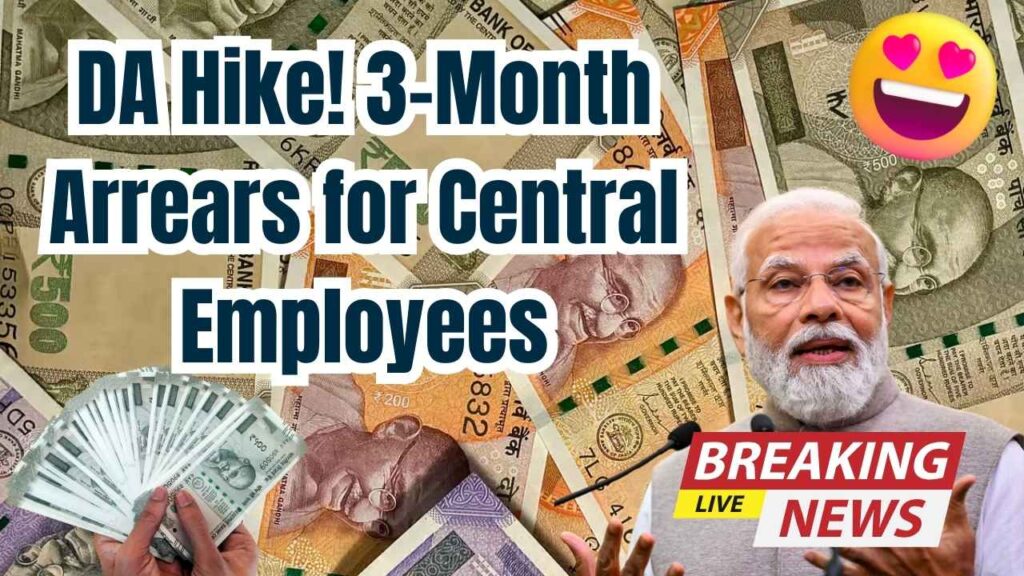
DA Hike Alert: In great news for millions of central government employees and pensioners, the Union Cabinet has approved a 2% hike in Dearness Allowance (DA) and Dearness Relief (DR). Effective January 1, 2025, this increase takes the DA from 53% to 55% of basic pay or pension, with arrears for January to March 2025 set to be paid out with the April 2025 salary.
This hike is not just a number—it translates into real financial support amid rising inflation, affecting over 4.86 million employees and 6.65 million pensioners across India.
DA Hike Alert
| Aspect | Details |
|---|---|
| DA Increase | 2% (from 53% to 55%) |
| Effective Date | January 1, 2025 |
| Arrears Disbursement | With April 2025 salary/pension |
| Employees Benefitted | Approx. 4.86 million |
| Pensioners Benefitted | Approx. 6.65 million |
| Annual Financial Burden | ₹6,614.04 crore (per government estimates) |
The 2% DA hike is more than just an administrative adjustment—it’s a lifeline for millions of families battling inflation. With arrears for three months to be credited in April 2025, this move brings welcome relief, especially to pensioners and fixed-income households. The revision is in line with the government’s inflation-tracking policy and economic welfare commitments.
As always, it’s essential for employees and pensioners to review their payslips, plan taxes smartly, and stay connected to official portals for timely updates.
What is Dearness Allowance and Why It Matters
Dearness Allowance (DA) is a cost-of-living adjustment paid to government employees and pensioners to help them cope with inflation. It is calculated as a percentage of the basic salary or pension and is revised every six months—January and July—based on the All India Consumer Price Index (AICPI).
“DA is a critical component for government employees, especially in a volatile economy. It ensures their salaries maintain purchasing power,” says Rajeev Dubey, Senior Policy Analyst at India Budget Watch.
How the New DA Impacts You – With Examples
For Employees:
- Basic Pay: ₹18,000
- DA Increase: ₹360/month (2% of ₹18,000)
- Arrears (Jan–Mar): ₹360 × 3 = ₹1,080
For Pensioners:
- Basic Pension: ₹9,000
- DA Increase: ₹180/month
- Arrears (Jan–Mar): ₹540
You can verify the increased DA in your April 2025 pay slip or pension statement.
Historical Trends in DA Increases
| Year | DA % Before Hike | DA % After Hike | Month of Revision |
|---|---|---|---|
| 2021 | 17% | 28% | July |
| 2022 | 31% | 34% | January |
| 2023 | 38% | 42% | July |
| 2024 | 50% | 53% | January |
| 2025 | 53% | 55% | January |
This consistent increase underscores the government’s commitment to income protection in the face of economic pressures.
How DA Affects Retirement Planning
For pensioners and mid-career employees, DA plays a vital role in long-term financial planning:
- DA directly impacts pension: Higher DA at the time of retirement increases the pensionable salary.
- Gratuity and Leave Encashment: These are partially calculated using the DA component.
- Tax Planning: Since DA is taxable, it may affect your income tax slabs.
Tip: Consider using tools like the Income Tax Calculator to estimate your tax impact.
Comparing Central & State Government DA
While central employees just received a 2% hike, several state governments are also in the process of revising DA rates. For instance:
- Uttar Pradesh and Haryana recently aligned their DA rates with the Centre.
- Some states like West Bengal have separate timelines, often with delays.
This variation stems from different budgetary priorities, but generally follows the central DA pattern.
Expert Insight: Economic Impact
Economists suggest that though the DA hike adds ₹6,600 crore annually to the government’s fiscal burden, it’s a well-calibrated move.
“This decision boosts consumer spending and offers inflation protection, especially ahead of the financial year’s close,” says Dr. Shubhangi Rao, Professor of Economics at Delhi University.
Checklist: What Should You Do Now?
Check April Payslip – Ensure your DA hike and arrears are reflected.
Update Tax Projections – DA is taxable. Update your Form 16 estimates.
Plan Savings – Use the extra income to boost emergency funds or investments.
Consult HR – For discrepancies or clarification, speak with your accounts department.
Use Official Portals – Always verify with https://www.pensionersportal.gov.in for pension updates.
Update Your PM Kisan Mobile Number Online to Receive 20th Installment Without Delay
Supreme Court Ruling: Will a Will or Power of Attorney Give You Property Ownership Rights?
Metro Update: Purple Line in Kolkata Set to Begin Operations Between Key Stations
Frequently Asked Questions About DA Hike Alert
Q1. What is the effective date of this DA hike?
January 1, 2025, with arrears paid in April 2025.
Q2. Who is eligible for this hike?
All central government employees and pensioners, including civilian and defense personnel.
Q3. Is the DA hike applicable to contractual staff?
No, DA is generally applicable only to regular government employees and pensioners.
Q4. How can I calculate my revised salary?
Multiply your basic pay by the new DA rate (55%) and subtract the previous DA (53%) to get the difference.
Q5. Will this affect my HRA or other allowances?
Yes, some allowances like Transport Allowance (TA) and Gratuity are impacted by DA changes.







